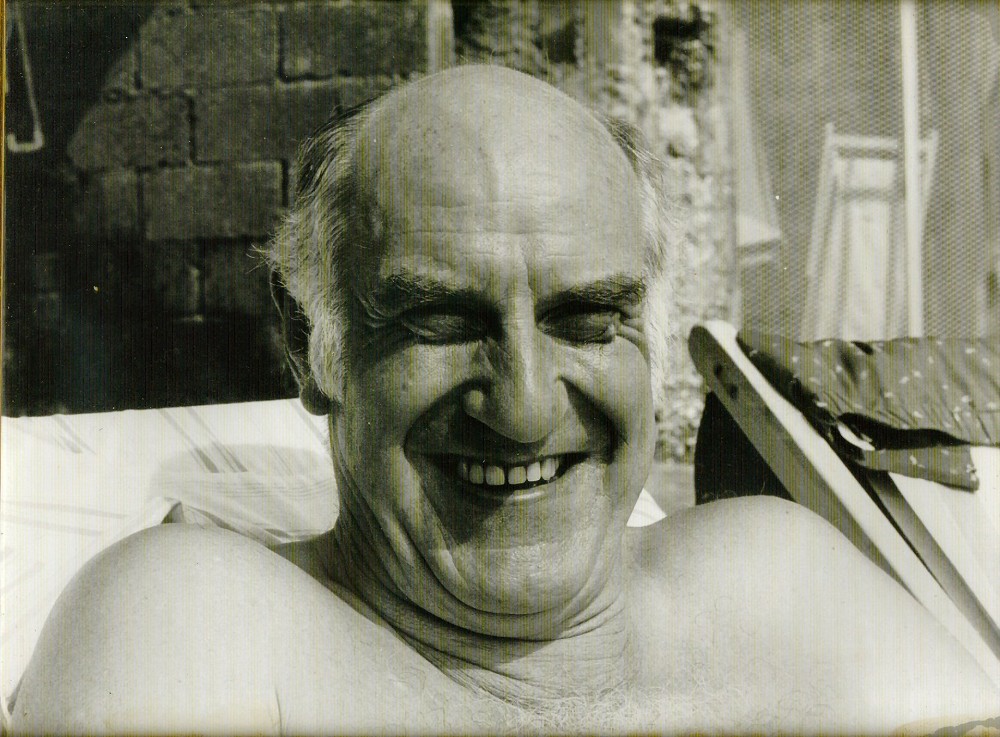The marriage of Frederick Charles Smith and Sarah Hildick took place on 12/9/1883 at The parish church in Lapworth, Warwickshire.
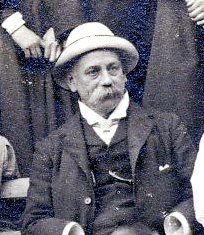
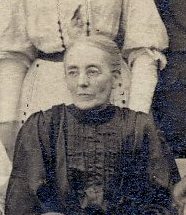
Frederick Charles Smith Sarah Hildick
One of the witnesses to the wedding is shown as being Mary Jane Howard Smith, sister to Frederick and later to marry Sarahs brother John. This would indicate that Fredericks father Joseph was dead, although Mona records his death as being in 1888 . This has not been verified.
The wedding was carried out by Frederick Smith, who was the uncle of Frederick, and the vicar of Astonbrook in Birmingham. I suppose if you have a vicar in the family you would use him if you could. It is interesting that Sarah was living at Gospel oak House, Lapworth at the time of her marriage. The 1881 census places the Hildick family in Walsall, the farm must have been unoccupied by the Hildicks since Joseph Robert Hildicks death in 1877. They must have moved there between 1881 and 1883.
They had 8 children:
Gavin b1884
Jessie Mary b1885
Frances Ida b1886
Frederick Charles Attwood b1889
Dorothy Sinah b1890
Marjorie Mona b1892
John Norman b1894
Joseph Donald Torrance b7/1/1895
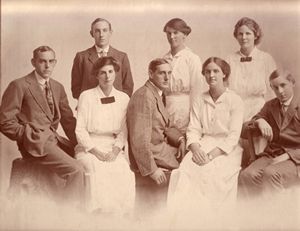
The original eight Hildick-Smith children c 1910
Back Row (L-R): John, Jessie,Dorothy
Front Row (L-R): Frederick (Attwood), Ida, Gavin, Mona, Joseph Donald
According to census records in 1891 the family were living at Gospel Oak House, Lapworth with Sarahs father and mother John and Jessie Hildick. Frederick is shown as a master currier.
At the 1901 census Frederick and Sarah were back at “Brookfield” (now shown as) Birmingham Road, Walsall which appears to be the family home and employed both a housemaid and a cook there. There is anecdotal evidence that Frederick may have abandoned the family soon after and this is confirmed by Ida Wolstenholme, Gavin Hildick-Smiths daughter who intimated that his departure may have had something to do with a pregnant housemaid. It is reported that he went to Russia for some reason, and that his son Gavin (see below) went there to talk his father into returning to the UK, only to fail. No more is known of Fredericks fate at present although there is a record of the death of a Frederick Smith in St Petersburg in 1911. This has not so far been verified.
Ida reported that her granny Sarah was a very strong willed and somewhat fierce character who stood no nonsense and scared the children a little. Who financed the South African adventure is not known but it is likely that Gavin went there as a newly qualified mining engineer to work and liked the life so much that some of the others followed on. Ida could not recall her granny Sarah ever making the trip but all the other children did and some stayed longer than others.
Mona Hildick-Smiths letter descibes vividly the events leading up to Fredericks departure and is quite sure who was to blame for the split:
“When Grandfather Smith (Joseph Howes Smith) died my father (Frederick Charles) being the only son, was in the leather business which he hated, he wanted to be an engineer and his father wouldn’t let him- After Grandfather died, my father seemed to go less and less to the warehouse and there seemed to be awful rows in the house-which one day reached a climax and my father left and he never came back.
I was 8 years old (in 1901) and I can still see him now after all these years-he was over 6 ft tall broad shouldered with very blue eyes. He always came home to lunch and then used to come upstairs to our nursery, to say goodbye before going back to the warehouse and he always rode a bicycle- This particular day he seemed to spend longer in the nursery than usual and when he went out of the gate he waved his hand to us-we were watching from the window- and instead of him going towards Walsall, he went the other way to Birmingham and that is the last I ever saw of him”
She continues:
“He was awfully fond of us all, but knowing what my mother was like when I grew up-I think a lot of the faults where(sic) on her side-my father played the piano beautifully-I know it sounds dreadful to say a man left his wife with 8 children to look after but there are two sides to everything. I have asked people in Walsall who knew him and they said he should never have married Sarah Hildick--------“
It seems that Mona blamed her mother for the split and held no animosity towards her father despite never seeing him again. She says she was 8 when the split happened, Frederick appears in the 1901 census records so must have left home after April 1901. It is not yet known when or where he died.
Sarah Hildick died in 1936.
According to details received from America all the family styled themselves Hildick-Smith except for Dorothy, who never adopted the surname. It has to be noted that none of the children were registered under the Hildick-Smith surname, being listed in the registers as Smith, with no recording of the Hildick attachment.
I suspect that Sarah Hildick was the founder of the name, it is obvious that she had to be strongly independent and probably unwilling to fully forego her maiden name.
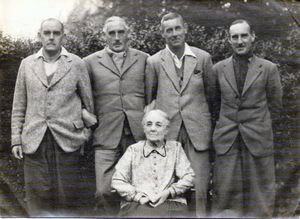
Frederick C A , Gavin, Joseph Donald and John Norman
With mother Sarah (Hildick) c 1930
The following details have been supplied by Peter and Andrew Hildick-Smith in America, supplemented by some research carried out in the UK by Jackie Morris, my own research and and by talking to Ida Wolstenholme.
Gavin Hildick-Smith
Gavin was born in 1884 in Walsall and was educated at a boarding school in Moseley, Birmingham. He trained as a mining engineer and went out to South Africa in about 1904. Most of the family visited him, imcluding my grandfather Joseph Donald. As the eldest son of the family he seems to have been the family focus, encouraging and helping his siblings in the absence of his father. His mother, a formidable character, never went to South Africa and Gavin acted “in loco parentis”. He worked at the Modder B mine near Johannesburg, eventually working his way up to be the Mine Manager. He was a keen golfer and polo player and also, with the help of his brother Frederick (Atwood) bred beef cattle and polo ponies. He met and married Jessie (Nettie) Gray Younger on 28/7/1915 in Yeoville, Johannesburg.
[Jessie was born at “Bankwood”, Scoonie, Fife on 27/5/1884, the daughter of John Beath Bealson Charles Younger, a farmer of North Callangs, and Jessie G Duncan of Kingsbarn.They had five children, Charles John 1879-1883, Nancy Adair b1881, Mary Alice b1882, Jessie Gray b1884 and Lewis b1888. Lewis was a decorated soldier in WW1, winning both an MC and soon after a Bar. Jessie G Duncan was related to Admiral Adam Duncan, the naval hero of Camperdown. Ida Wolstenholme said her mother joined the First World War effort as a nurse and went to German West Africa to serve. She met Gavin there, fell in love and stayed on to marry.Gavins grandson, Andrew Hildick-Smith has a memoir written by Jessie detailing her early life in great detail together with much detail of her ancestors)
He did not return to England at the start of WW1 but signed up to fight in South Africa. Other members of the family who had been in South Africa at the time, did return. He certainly served in the forces but in Southern Africa as this is where he met his future wife during the War. A photo album I have has a picture of some of the family travelling back from Durban to London on board RMSS Saxon in April 1916. As yet no definite details of any war record have been found.(6 Gavin Smiths have been found, all non-officers serving with either the Royal Field Artillery or Scottish regiments.) He was in South Africa at the end of the war to resume his career and he did a tour of duty in Spain managing construction of a railway tunnel through the Pyrenees. Andrew Hildick-Smith has several photos of Gavin when he worked as a project manager in Spain including one at the opening of a railway station in Madrid taken in 1927 which features the then King and Queen of Spain.
He seemed to have been a great supporter of the black workers at the mine, indeed in 1923 he was taken to * court by the SA government for using “blacks on work above their station” but won the case. The case was used as an argument by Mahatma Ghandi in subsequent discussions with the British Raj before Indian Independence.
(Ref: Interview on the Colour Bar Bill June 8th 1926 published in the Bombay Chronicle June 9th 1926. *Rex v Hildick-Smith).
They lived in a beautiful large house near the Modder B mine, with an English style garden. Ida Wolstenholme, their daughter, has many photos of her time there.
Gavin and Nettie had 3 children. One is still living, one died in the WW2 and the other Gavin died in 2006.
Joan “Wendy” was born in 1918 in Johannesburg. At the outbreak of WW2 she returned to England and enlisted in the Womens Transport Service, F.A.N.Y (Ambulance Division). She was returning to Durban, South Africa, out of Liverpool, on board SS Ceramica of the White Star line, when, on Saturday/Sunday 7th/ 8th December 1942, the ship was torpedoed by the German submarine U-515. Only one man, Sapper Eric Monday, was picked up by the U Boat, which then left the remaining 655 of the ships company to perish. No other survivors were ever recovered.
For the full story of this tragedy see : http://www.ahoy.tk-jk.net/macslog/SSCeramicavictimofU-515.html]
A book detailing the tradgedy was published in early 2006.
(Andrew H-S writes after his visit to us in June 2006:
“I do not think I ever told you that my Dad had told me on the night of the sinking, way before any problem was public, Ida had dreamed that Wendy (Joan) was drowning and calling out for help. The next day Ida described her experience and said she thought Wendy was dead. Because of that incident, my Dad always believed that ESP or something like it, existed.”)
Gavin “Pete” Younger was born in Johannesburg in 1919 and was educated in the UK at Haileybury College and Trinity College, Cambridge. He then studied Pediatrics at Guys Hospital in London. He had great success as an amateur squash player, winning the British Open title (then considered to be the world championship of squash) in 1951. He met his future wife Eutha (Kit) Richter from New York City at a dinner given by friends in London. She was then working as a secretary at the US Embassy in London. They married on 3.3.1953 and moved to Toronto. Pete gave up practising medicine in 1955 to do pharmaceutical research, first at Squibb and then for the rest of his career at Johnson and Johnson. Kit and Pete had lived at Princeton, NJ since 1955 but retired to live in Highstown,NJ in 2003. He died in January 2006 and his obituary is shown here:
"Gavin Y. (Pete) Hildick-Smith, M.D., 86, of Princeton, died January 8 2006 at the University Medical Center at Princeton.He was a director in the corporate Office of Science & Technology at Johnson & Johnson, where he worked for 37 years. During his tenure at J&J he focused on searching for new opportunities in medical research for the company.Born in Johannesburg, South Africa, Dr. Hildick-Smith was educated in England at the Haileybury School, and at Trinity College, Cambridge. He did his medical studies at Guy's Hospital and Great Ormond St. Children's Hospital in London, specializing in pediatrics, which he practiced in South Africa, the UK, Canada and the U.S. His wide ranging interests led him into other medical fields, where he co-authored the medical text book Fungus Diseases and Their Treatment, and was an editor of the books Skin Bacteria and Their Role in Infection, The Surgical Wound, and The Infection Prone Hospital Patient. He was honored to be named a Fellow of the Royal College of Physicians in the UK in recognition of his contributions to medicine.He was also a gifted athlete. In the 1950s he was the national squash champion in South Africa and England. In earlier years he was a keen cricketer and rugby player. He was also an avid, lifelong fly fisherman who fished the world over in pursuit of this passion.A 50-year resident of Princeton, he was a member of the Pretty Brook Club and the Nassau Club.He is survived by his wife Kit; two sons, Peter of Sleepy Hollow, N.Y., and Andrew of Winchester, Mass.; and six grandsons.A memorial service will be held at Trinity Church this Friday, January 13 at 11:30 a.m. In lieu of flowers, memorial contributions may be made either to the Stony Brook-Millstone Watershed Association, 61 Titus Mill Road, Pennington 08534; or to The Children's Hospital of Philadelphia, 34th & Civic Center Boulevard, Philadelphia, Pa. 19104."
This from: http://www.towntopics.com/jan1106/obits.html#obit4
They have two sons both living.
Jessie Mary Hildick-Smith
Like the rest of the family attended Queen Mary’s Walsall, she married Joseph Yardley who was a Merchant Seaman and sailed the Horn at least 3 times; He was in the navy during the war, and then had a steel business in Willenhall after the war. They retired to Newton Ferrers to enjoy messing about in boats once more. They had two children.
Frances Ida Hildick-Smith
Only 10 months younger than Jessie, she was always rather the rebel. She never married but lived in Mortimer near Reading and ran the Brownies for about 3 generations. During the war she had been a Land Girl, after her Mother’s death in 1936 (at the age of 86) she cut herself off from the family, but communication was restored by her sending an invitation to her niece to stay in 1942. This was accepted (with a certain reluctance by the interested party) but communication from thenceforth was restored!
Frederick Charles Attwood Hildick-Smith
Frederick was named for his father and his paternal grandmother maiden name and was always known just as Attwood. He was asthmatical, but a great favourite, he also went out to South Africa and worked on the gold mine, returning for war service. As a Captain in the Royal Engineers he fought in France from early 1916. He was recorded under the name Attwood H Smith in the Medal Index cards held by the National Archive centre in London. By all accounts he managed the farm while his brother Gavin worked at the mine. He remained a bachelor for a long time and finally married Ivy his housekeeper. Little more is known of his life at present except that he had no known children and died in South Africa sometime after WW2.
Dorothy Sinah Hildick Smith
By 1908 it was permissable for girls to receive training. So Dorothy was fortunate to go to Bedford to the Physical Training College for the two year course. This was encouraged by the gymnastic teacher at Queen Mary’s – Gertrude Bache – the sister of her future husband. She taught in Exeter, and Godalming and married Eric Bache in 1917(?), having been engaged throughout the war. They had 3 daughters
Marjorie (Mona) Hildick-Smith
She also went to College, to a domestic science college in Manchester. She was adept at sewing and needlework, and she seemed to be always on the move. The longest that she stayed in any job was at Bryanston School (a private boarding school in South Africa) where she stayed 7 years from its inception in 1925. She travelled to South Africa a number of times, and spent some years looking after her Mother, being ‘always in the right’ did not endear her to employers or employees, but she remained fiercely independent. She is recorded as a housekeeper at Victorian College in Cairo from 1946 to 1947. She and Frances (Ida) did not speak to each other for 20 years but did apparently make up later in life. She never married and died in England in 1981. Her letter to America has been most useful in putting real colour to the story of the Hildick-Smith family.
John Norman Hildick-Smith
He attended Queen Marys Grammar School and was a leading member of the Cadets at the school. It is possible that he too went out to South Africa but he returned to the UK for the start of the First World War. He joined the 5th Battalion, South Staffordshire Regiment (Service Number 294149). He served in France where the appalling death toll meant that he rose rapidly from the rank of 2nd Lieutenant. As an acting Captain he was awarded an MC (Militiary Cross) in Jan 1918. (I have yet to track down the medal citation.)
Near the end of the war he was seconded to the Indian Army and married his Colonel’s daughter Kathleen Maude Rivett-Carnac – for details of this very distinguished family go to http://freepages.genealogy.rootsweb.com/~usher/ushersct/surnames.htm. They had 3 children, who lived in England for their education, whilst he continued in the army. He again rose in the ranks and served as a colonel in the 2nd World War. He was retired in 1944 and was granted the honarary rank of Brigadier. His family nickname was “Niblick” due to his prowess at golf.
Joseph Donald (Don) Torrance Hildick-Smith
Joseph took his name from his paternal grandfather Joseph Howes Smith and his maternal grandmother Jessie Isabella Torrance although he was always only known as Don. He was born on 7/1/1895 at Highgate Road, Walsall and followed his family to South Africa where he worked mainly on the farming side, breeding beef cattle and polo ponies for his brothers. Before the war he had made trips to South Africa but came home to learn English farming with Rupert Bache at Stakenbridge, Churchill, Worcestershire. This is obviously how he met his future wife Elsie Oldnall Page. Rupert was Elsies brother- in- law.(See entries for the Page family later).
He joined the 14th Hussars as a Private (No 42498) to serve in WW1. His medals indicate that he did not serve in France until after 1916. It seems that the Hussars were based in the Middle East and fought in Iran and Iraq, although I never heard him talk of it.
A family story goes that he was shipwrecked whence he used his two fingered whistle to attract the attention of a passing boat – many of them were saved by this but he is reputed never to have used his whistle again. (This may be indeed be anecdotal but as a boy I remember him having a dog who was meant to be for shepherding but as I recall Grandpa couldn’t whistle well enough for the dog to respond. The dog eventually went to another farm where it turned into an excellent sheep herder. Its name was Gyp, I think.)
After the war he went back to South Africa in 1919, despite having fallen for Elsie. He soon returned and they were married at St Cassians Church, Chaddesley Corbett on April 8th 1926 after what was obviously a long courtship. The marriage service was conducted by H Norman Bache, a relation of Rupert Bache. He never seemed very strong and after his marriage to Elsie Page (sister to Rupert Bache’s wife) he kept chickens at The Barn in Chaddesley Corbett, afterwards working in a butcher’s shop and as a delivery driver for the local bakery. In his later life he worked as a seed potato merchant. He was a keen cricketer and served for many years as an umpire for the local club.
He contracted cancer of the liver and pancreas and died after a long and painful illness, at The Barn on 15/3/1959 aged 64.
I don’t remember him when he wasn’t ill, but he always had a cheery smile for us kids and I remember the smell of tobacco in his room. He was a lifelong smoker but his final disease was not at that time linked to his habit which I am afraid I have inherited. He never owned “The Barn” which Grandmother was given as a wedding present by her father John Page.
Elsie Oldnall Page (b 6/5/1895) was the daughter of John Oldnall Page, from a very well known local farming family who owned several farms in the Chaddesley Corbett area. (Her mother, Frances Smart, was related to the Ward family, Barons of Dudley, and by default to the House of Plantagenet. A family tree does exist, researched by a member of the Smart family and appears later.) Elsies father John Oldnall Page had built a barn at Dorhall in the late 1800s which he constructed in such a way as to make conversion into a house comparitively easy, and in 1932 the couple took up residence at The Barn, Dorhall, Chaddesley Corbett. She was very religious and encouraged all her grandchildren to attend Sunday School, although slightly put out that the only one available was run by the Methodists. I sang in their choir and later on at St Cassians Church where the whole family had been christened and where my father is buried.
She taught us to play Bezique, an obscure card game and preferred this to TV. She frequently took us with her on her regular visits to various family members around the village, walking miles in the process. When Don fell ill she nursed him at home, and, according to my mother, not always devotedly. I think she found it hard to see him like that and had little help except for an occasional visit by the local nurse and doctor. In those days respite care and sophisticated drug therapy just didn't exist. After his death she declined in health and Elsie died of heart failure in 1962 aged 65. More on Elsies family, the Pages appears later.) They had one son, David John.
David John Hildick-Smith was born at The Barn on 9/1/1928. He suffered a bad bout of rheumatic fever as a child and had a weak heart for most of his life, although at 6ft 7 inches tall and weighing 17 stones he always gave the impression of being very physically fit. He attended Chaddesley Corbett Endowed School and Hartlebury Grammar School but, by his own admission, never really took to learning. He worked for his uncles at various Page family farms but in the decline of agriculture after the war he took up security work, serving as a Works policeman at Hartlebury Rocket Research Establishment for many years. He was a great handyman and turned his hand to almost any sort of construction, decorating, plumbing or gardening job. The Barn had a large garden and it was always well cultivated to produce fruit and vegetables for the ever swelling ranks. In fact he was offered the opportunity to go to South Africa before the 2nd World War to help on the family farms there but his mother would not let him go. He did not serve in WW2, primarily because of his heart problems and age, but also in support of the wartime food production effort. He met his future wife just after the war. She had come to Chaddesley Corbett after service in the Land Army, to look after horses.David was married in Hendon, London in 1948 and lived at The Barn with Don and Elsie.They had 5 children.
David John Hildick-Smith died on 24/12/1984 of a pulmonary embolism and is buried in the churchyard of St Cassians Church, Chaddesley Corbett.
